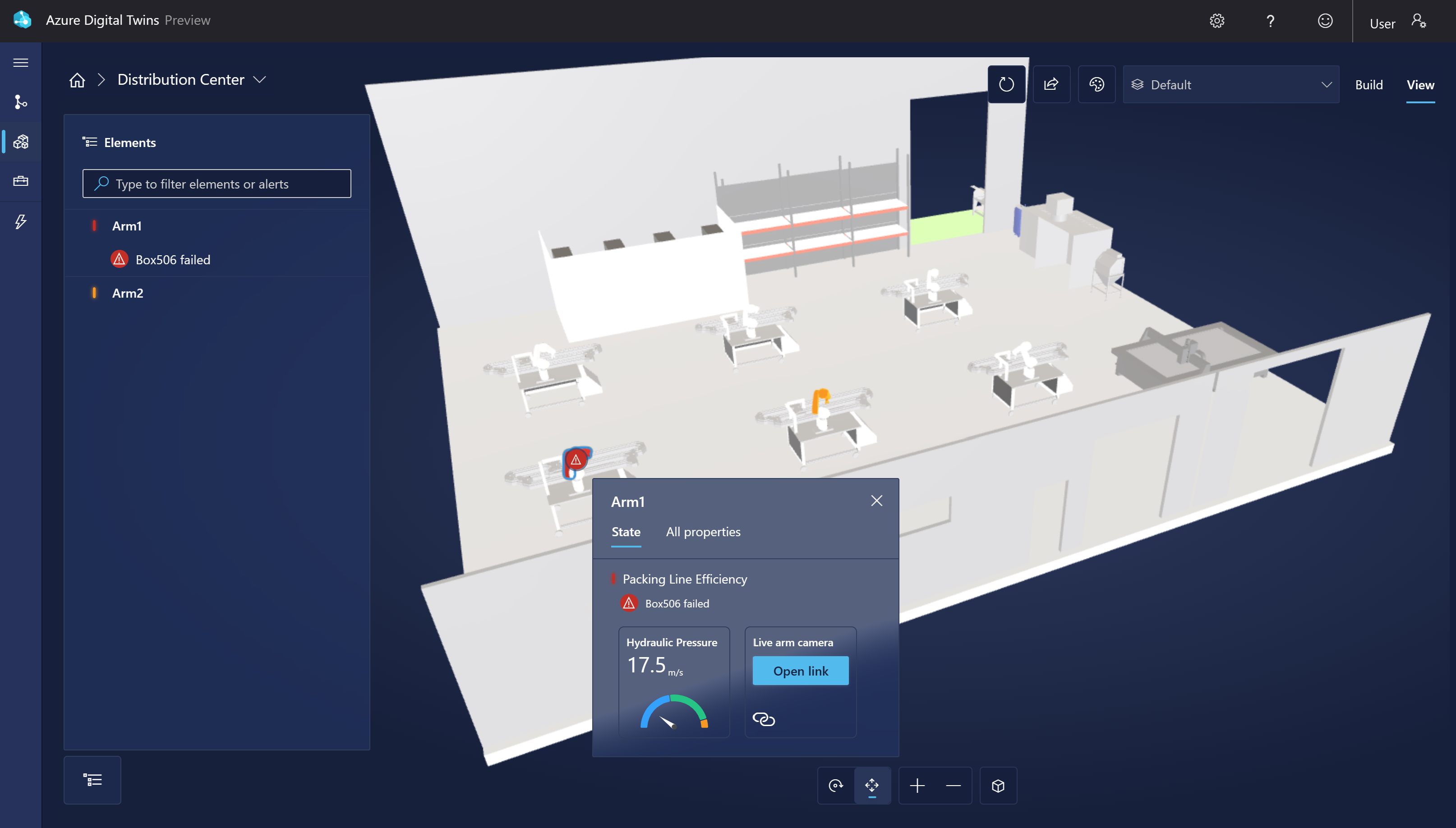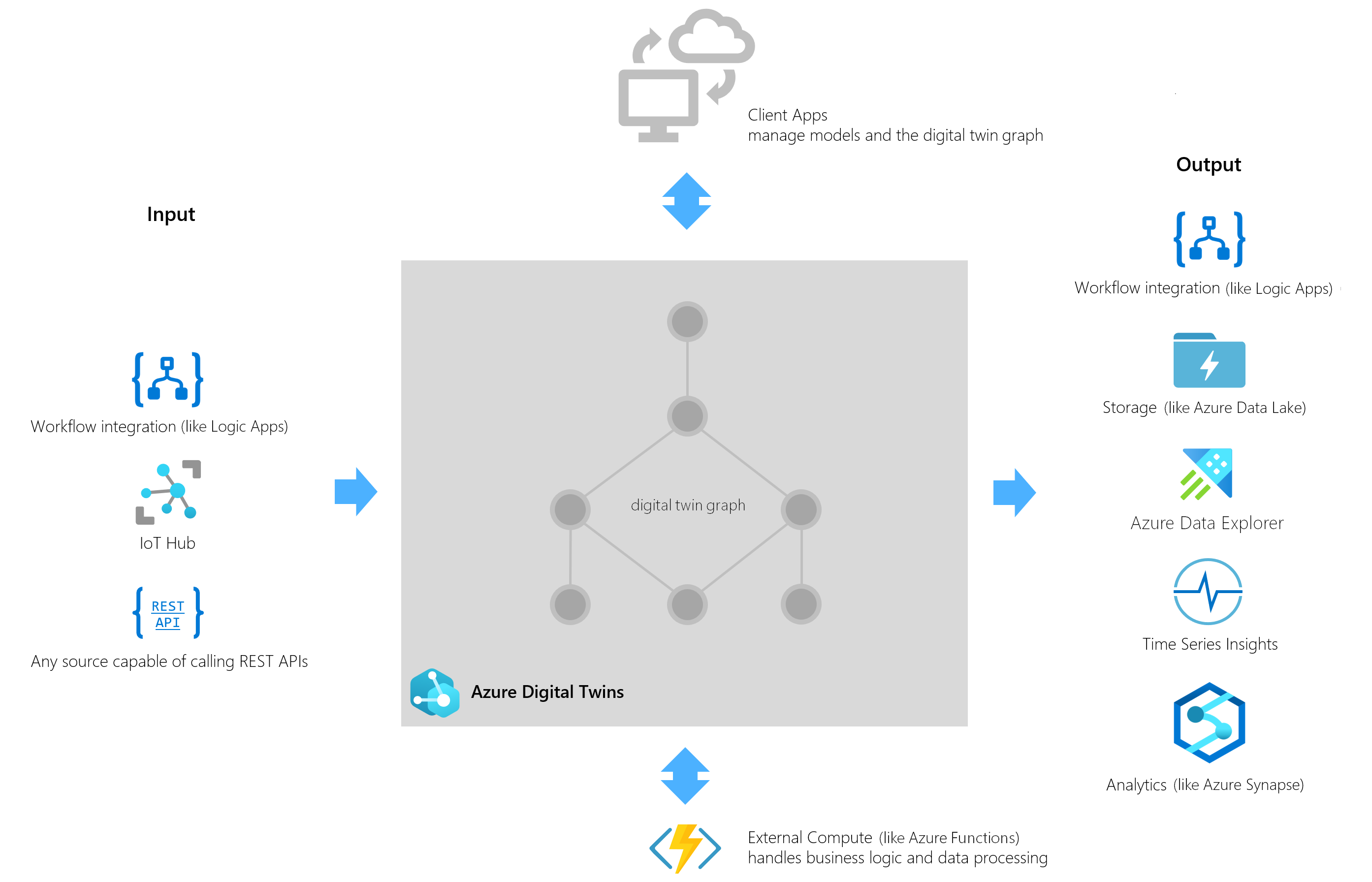What is Azure Digital Twins?
Azure Digital Twins is a platform as a service (PaaS) offering that enables the creation of twin graphs based on digital models of entire environments, which could be buildings, factories, farms, energy networks, railways, stadiums, and more—even entire cities. These digital models can be used to gain insights that drive better products, optimized operations, reduced costs, and breakthrough customer experiences.
Azure Digital Twins can be used to design a digital twin architecture that represents actual IoT devices in a wider cloud solution, and which connects to IoT Hub device twins to send and receive live data.
Note
IoT Hub device twins are different from Azure Digital Twins digital twins. While IoT Hub device twins are maintained by your IoT hub for each IoT device that you connect to it, digital twins in Azure Digital Twins can be representations of anything defined by digital models and instantiated within Azure Digital Twins.
Take advantage of your domain expertise on top of Azure Digital Twins to build customized, connected solutions that:
- Model any environment, and bring digital twins to life in a scalable and secure manner
- Connect assets such as IoT devices and existing business systems, using a robust event system to build dynamic business logic and data processing
- Query the live execution environment to extract real-time insights from your twin graph
- Build connected 3D visualizations of your environment that display business logic and twin data in context
- Query historized environment data and integrate with other Azure data, analytics, and AI services to better track the past and predict the future
Define your business environment
In Azure Digital Twins, you define the digital entities that represent the people, places, and things in your physical environment using custom twin types called models.
You can think of these model definitions as a specialized vocabulary to describe your business. For a building management solution, for example, you might define a model that defines a Building type, a Floor type, and an Elevator type. Models are defined in a JSON-like language called Digital Twins Definition Language (DTDL). In Azure Digital Twins, DTDL models describe types of entities according to their state properties, components, and relationships. You can design your own model sets from scratch, or get started with a pre-existing set of DTDL industry ontologies based on common vocabulary for your industry.
Tip
Version 2 of DTDL is also used for data models throughout other Azure IoT services, including IoT Plug and Play. This compatibility helps you connect your Azure Digital Twins solution with other parts of the Azure ecosystem.
Once you've defined your data models, use them to create digital twins that represent each specific entity in your environment. For example, you might use the Building model definition to create several Building-type twins (Building 1, Building 2, and so on). You can also use the relationships in the model definitions to connect twins to each other, forming a conceptual graph.
You can view your Azure Digital Twins graph in Azure Digital Twins Explorer, which provides an interface to help you build and interact with your graph:
Contextualize IoT and business system data
Digital models in Azure Digital Twins are live, up-to-date representations of the real world.
To keep digital twin properties current against your environment, you can use IoT Hub to connect your solution to IoT and IoT Edge devices. These hub-managed devices are represented as part of your twin graph, and provide the data that drives your model. You can create a new IoT Hub to use with Azure Digital Twins, or connect an existing IoT Hub along with the devices it already manages.
You can also drive Azure Digital Twins from other data sources, using REST APIs or connectors to other Azure services like Logic Apps. These methods can help you input data from business systems and incorporate them into your twin graph.
Azure Digital Twins provides a rich event system to keep your graph current, including data processing that can be customized to match your business logic. You can connect external compute resources, such as Azure Functions, to drive this data processing in flexible, customized ways.
Query for environment insights
Azure Digital Twins provides a powerful query API to help you extract insights from the live execution environment. The API can query with extensive search conditions, including property values, relationships, relationship properties, model information, and more. You can also combine queries to gather a broad range of insights about your environment and answer custom questions that are important to you. For more details about the language used to craft these queries, see Query language.
Visualize environment in 3D Scenes Studio (preview)
Azure Digital Twins 3D Scenes Studio (preview) is an immersive visual 3D environment, where end users can monitor, diagnose, and investigate operational digital twin data with the visual context of 3D assets. With a digital twin graph and curated 3D model, subject matter experts can leverage the studio's low-code builder to map the 3D elements to digital twins in the Azure Digital Twins graph, and define UI interactivity and business logic for a 3D visualization of a business environment. The 3D scenes can then be consumed in the hosted 3D Scenes Studio, or in a custom application that leverages the embeddable 3D viewer component.
Here's an example of a scene in 3D Scenes Studio, showing how digital twin properties can be visualized with 3D elements:
Share twin data to other Azure services
The data in your Azure Digital Twins model can be routed to downstream Azure services for more analytics or storage.
To send digital twin data to Azure Data Explorer, you can take advantage of Azure Digital Twin's data history feature, which connects an Azure Digital Twins instance to an Azure Data Explorer cluster so that graph updates are automatically historized to Azure Data Explorer. You can then query this data in Azure Data Explorer using the Azure Digital Twins query plugin for Azure Data Explorer.
To send digital twin data to other Azure services or ultimately outside of Azure, you can create event routes, which utilize Event Hubs, Event Grid, and Service Bus to send data through custom flows.
Here are some things you can do with event routes in Azure Digital Twins:
- Store Azure Digital Twins data in Azure Data Lake
- Analyze Azure Digital Twins data with Azure Synapse Analytics, or other Microsoft data analytics tools
- Integrate larger workflows with Logic Apps
- Send data to custom applications for flexible and customized actions
Flexible egress of data is another way that Azure Digital Twins can connect into a larger solution, and support your custom needs for continued work with these insights.
Sample solution architecture
Azure Digital Twins is commonly used in combination with other Azure services as part of a larger IoT solution.
A possible architecture of a complete solution using Azure Digital Twins may contain the following components:
- The Azure Digital Twins service instance. This service stores your twin models and your twin graph with its state, and orchestrates event processing.
- One or more client apps that drive the Azure Digital Twins instance by configuring models, creating topology, and extracting insights from the twin graph.
- One or more external compute resources to process events generated by Azure Digital Twins, or connected data sources such as devices. One common way to provide compute resources is via Azure Functions.
- An IoT hub to provide device management and IoT data stream capabilities.
- Downstream services to provide things like workflow integration (like Logic Apps), cold storage (like Azure Data Lake), or analytics (like Azure Data Explorer).
The following diagram shows where Azure Digital Twins might lie in the context of a larger sample Azure IoT solution.
Resources
This section highlights some resources that may be useful while working with Azure Digital Twins. You can view additional resources in the Resources section of this documentation set (accessible through the navigation links to the left).
Service limits
You can read about the service limits of Azure Digital Twins in the Azure Digital Twins service limits article. This resource can be useful while working with the service to understand the service's functional and rate limitations, as well as which limits can be adjusted if necessary.
Terminology
You can view a list of common IoT terms and their uses across the Azure IoT services, including Azure Digital Twins, in the Azure IoT Glossary. This resource may be a useful reference while you get started with Azure Digital Twins and building an IoT solution.
Next steps
Dive into working with Azure Digital Twins in the Get started with Azure Digital Twins Explorer quickstart or the Build out an end-to-end solution tutorial.
Or, start learning about Azure Digital Twins concepts with DTDL models.


